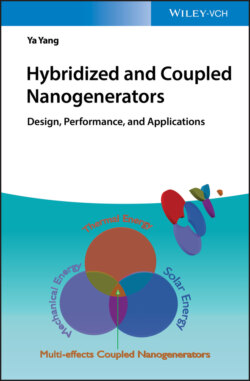Читать книгу Hybridized and Coupled Nanogenerators - Ya Yang - Страница 35
2.3.2.4 Nanoparticle and Nanowire
ОглавлениеNanoscale materials including nanoparticles and nanowires have attracted broad interest due to their unique chemical and physical characteristics. Unlike bulk materials, reducing the size of materials to the nanoscale could make them exhibit high reactivity. Nanoparticles (NPs) with high surface energy can be easily re‐formed into functional materials, and nanowires (NWs) offer high surface area and restrain the mechanical degradation [66]. These nanoscale materials have been widely used in applications of energy collecting and storing devices.
NWs with high surface area that restrain the mechanical degradation could be used to optimize the performance of TENGs. Jiang et al. developed a Ag nanowire‐based TENG, where Ag nanowires were used as both triboelectric layers and electrodes. Ag nanowires were fabricated through a polyol synthesis method [67]. Figure 2.8a,b shows that the diameter and length of the nanowire are about 70 nm and 10 μm, respectively. Photographic paper was used as the substrate to fix the Ag nanowire slurry, resulting in a metal electrode with excellent conductivity (Figure 2.8c). The Ag nanowires closely accumulate on the photographic paper to form the Ag nanowires membrane, as shown in Figure 2.8d. Cheon et al. fabricated PVDF–Ag NW composite by the electrospinning method. The electrostatic interactions between the Ag NWs and the dipoles of the PVDF chains could promote β‐phase crystal formation of PVDF, which can be further used to increase the output performance of the TENGs [68]. From a triboelectric perspective, NPs could increase the surface roughness and dielectric property of friction films, leading to enhanced performances of TENGs. Jiang et al. reported a Ag nanoparticle‐based TENG, where Ag nanoparticles were used as both triboelectric layers and electrodes [69]. Ag nanoparticles with a diameter of about 50 nm were fabricated through an ice−water bath method as shown in Figure 2.8e. The Ag nanoparticles were stuck on the photographic paper to form the Ag membrane, increasing the mechanical stability of nanoparticles, as shown in Figure 2.8f. It is found that the membrane could form positive charges when it made contact with a FEP film in the TENG.
Figure 2.8 Ag nanoparticles and Ag nanowires. (a) SEM image of the Ag nanowires. (b) High‐magnification SEM image of Ag nanowires. (c) A photograph of the electrode based on Ag nanowires. (d) The SEM image of the electrode.
Source: Reproduced with permission from Jiang et al. [67]. Copyright 2018, American Chemical Society.
(e) SEM image of the low‐density Ag nanoparticles on Al foils. (f) The membrane prepared by Ag nanoparticles on a photographic paper.
Source: Reproduced with permission from Jiang et al. [69]. Copyright 2017, American Chemical Society.
NPs can be used to increase the surface roughness of triboelectric layers. Lee et al. fabricated textile electrodes with nanostructured geometries, where Al NPs were grown by using thermal evaporation [70]. When the Al NPs were contacted with the PDMS, triboelectric charges could be generated due to their different triboelectric series. It is found that Al NPs could remarkably increase the output voltage of the TENG. Chun et al. developed an Au NP‐embedded mesoporous TENG, where Au NPs were embedded into the pores of the PDMS. It is found that the contact between Au NPs and PDMS could enhance the surface potential energy, resulting in high output performance of TNEG [71]. Zhang et al. explored the effect of the output performance of TENGs based on Cu NP‐embedded films and ZnO NP‐embedded films, respectively. The results showed that Cu NPs can effectively increase the output performance, but ZnO NPs hardly do that [72].
